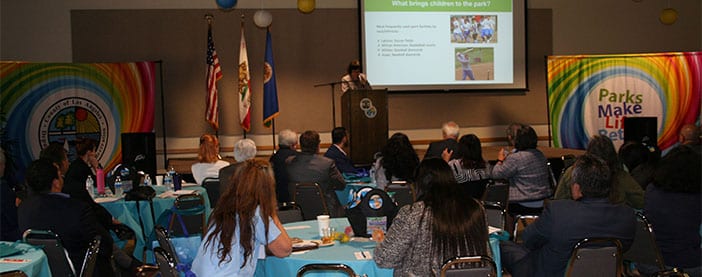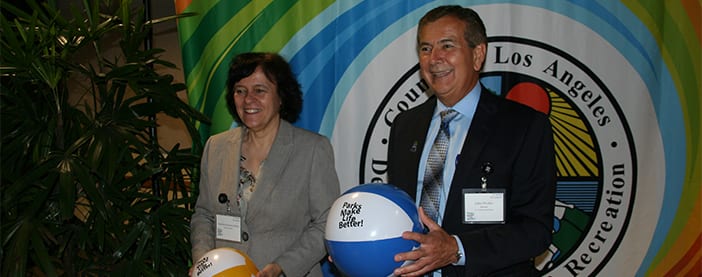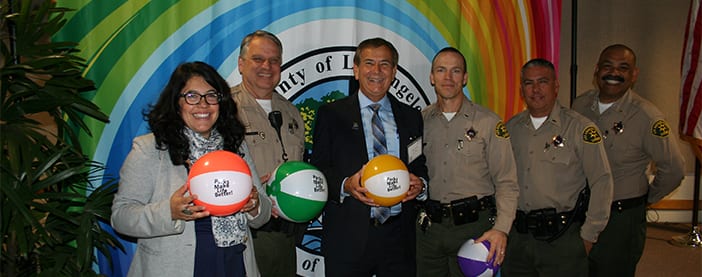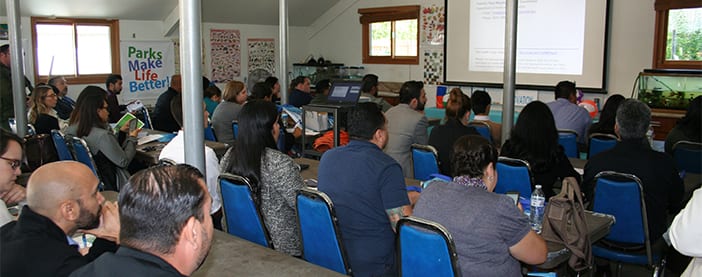Hundreds of park and recreation professionals, representatives of nonprofit organizations and other advocates for parks, natural areas and open space gathered May 14 for the 13th Annual Park Summit.at the Los Angeles County Arboretum. The theme: “Pursuing the Vision: What’s Next for Parks?”
Hosted by the Los Angeles County Department of Parks and Recreation, the yearly gathering featured a series of informative and dynamic workshops, as well as networking opportunities that helped participants form valuable partnerships. The workshops were focused on helping the estimated 350+ attendees form a vision for the future of parks and recreation, and giving them the tools to implement it. They included:
The Future of Parks… What Will You Need?
- The Financing Puzzle: Building on the General Fund
- Clever Collaborations
- Social Media… #What’sNEXT
- Social Landscapes: The Changing Faces of Recreation
- Hire, Don’t Fire: Successful Recruitment and Retention
- Placemaking: Historical Inspiration and Contemporary Expression
- The Power of Play: Transforming the Mind, Body and Human Spirit
Led by California Park and Recreation Society (CPRS) executive director Stephanie Stephens, the 2015 keynote was an informative and engaging panel discussion on forward-thinking innovation in park agencies. Panelists included Tim Barry, CPRS president and General Manager of the Livermore Area Recreation and Park District; Brian Albright, Director of the Department of Parks and Recreation, County of San Diego; and Pilar Alcivar-McCoy, Director, Signal Hill Community Services Department.
With “Clever Collaborations,” Sara Somogyi, Director of Recreation and Community Services for the City of Arcadia, discussed the benefits of building and maintaining successful relationships and how this can help your events/department in the future.
In “The Future of Parks …What Will You Need?” session, Los Angeles County Department of Parks and Recreation (LACDPR) Deputy Director-Planning & Development Norma E. Garcia, and LACDPR Project Director Rita Robinson provided an overview of the Countywide Park Needs Assessment now underway, as attendees learned how to help gather, document and report information that is important in their individual communities.
For “Placemaking: Historical Inspiration and Contemporary Expression,” GameTime executive Tom Norquist highlighted case studies of parks that achieved broad support by involving of the community in the “planning, design, management, and programming of public spaces.” One innovative idea: using elementary age youth in the park design process, by having them create their own play areas using miniature 3D models during arts & crafts play time. The children and families who use our parks, he noted, “are our best experts in the field.” Norquist led another session, “The Power of Play: Transforming the Mind, Body and Human Spirit,” during which he implored park professionals to tap in to their childlike imagination, and take care to maintain the idea of simple free play as a central value in their work.
As part of the “Hire, Don’t Fire: Successful Recruitment and Retention” session, two presenters — Joanne Conley, Lecturer and Internship Coordinator, California State University, Long Beach; and Johan Julin, Manager, Countywide Examinations, County of Los Angeles Department of Parks and Recreation — provided a variety of viewpoints, advice, and tips to aid in the recruitment, hiring, and retention of key recreation staff.
For the crowd gathered for the “Social Media… #What’sNEXT” panel, Jorge Nuno of NTS Studios and Los Angeles County Department of Parks and Recreation public information officer Andre Herndon shared their experiences and urged a roomful of park professionals to put social media at the center of their public-facing communications. In “The Financing Puzzle: Building on the General Fund” session, Jackie Carrera, former president and CEO of the Parks & People Foundation, discussed how the funding mix for parks, recreation facilities and recreation programs has changed over time, dug into the roles of the public and private sectors, and looked closely at non-tax funding sources that are being used to supplement municipal tax dollars.
Pilar Alcivar McCoy, Community Services Director for the City of Signal Hill, led the “Social Landscapes: The Changing Faces of Recreation” session. In it, she facilitated a robust discussion of the need for park and recreation agencies to stay mindful of demographic shifts in the communities they serve, including generational changes, ethnicity and economics.
“Parks are central to maintaining quality-of-life in our communities – and with a growing body of evidence confirming the physical and psychological benefits of outdoor recreation, parks will play an even greater role in the years and decades to come,” said Department of Parks and Recreation Director Russ Guiney. “Planning for that future is essential to our ability to serve effectively. The Park Summit is an indispensable forum for sharing knowledge, ideas and resources that will help us all continue to meet the challenge of demonstrating that ‘Parks Make Life Better!’”




